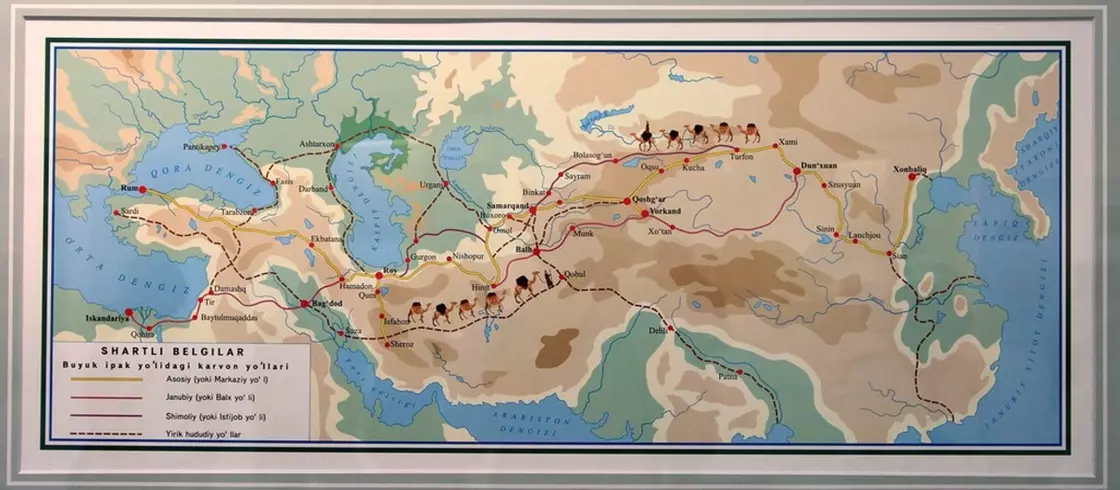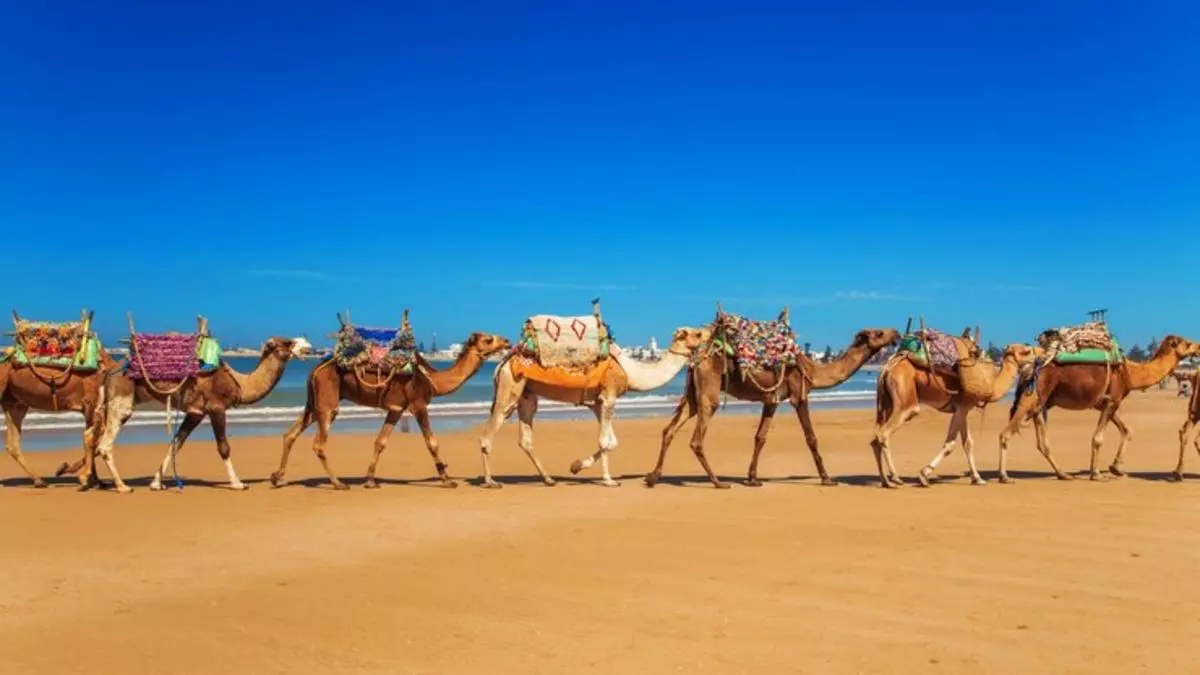Imagine walking along an ancient caravan trail, where centuries ago merchants carried silk, spices, and ideas across continents. The steppe wind whispers tales of the past, surrounded by mausoleums, ruins, and bustling bazaars that hold the memory of the Great Silk Road. In Kazakhstan, this route comes alive in the cities of Turkestan, Otrar, Taraz, and Sauran, where history blends with hospitality and the beauty of southern Kazakhstan. This isn’t just a trip—it’s a journey to the crossroads of civilizations. In this article, we’ll guide you through the caravan trails, highlight must-see spots, and share tips to plan an unforgettable adventure.
The History of the Silk Road in Kazakhstan
Over two thousand years ago, the Silk Road connected East and West, serving as a bridge for trade, culture, and knowledge. Kazakhstan, located at the heart of Eurasia, was a vital hub of this route. Through its steppes and cities—Turkestan, Otrar, Taraz—caravans traveled from China to Europe, carrying silk, porcelain, tea, and spices. Nomads, merchants, and scholars met here, exchanging goods, religions, and traditions.
Otrar thrived as a center of science and crafts, Turkestan became a spiritual capital thanks to the mausoleum of Khoja Ahmed Yasawi, while Taraz and Sauran protected caravans and flourished as trade hubs. Today, these places beckon travelers seeking not just history but unique experiences.

Key Cities of the Silk Road in Kazakhstan
Turkestan: The Spiritual Heart of the Steppes
Turkestan is a city where history breathes in every stone. Its crown jewel is the Khoja Ahmed Yasawi Mausoleum, built in the 14th century by order of Tamerlane. This architectural masterpiece, with its turquoise dome and intricate patterns, is a UNESCO World Heritage Site. A sanctuary for pilgrims and a magnet for tourists, it symbolizes Sufism. Legend says three visits to Turkestan equal a hajj to Mecca.
Nearby lies the Aziret-Sultan Historical and Cultural Museum-Reserve, housing Silk Road artifacts: pottery, coins, and manuscripts. Don’t miss the underground Hilvet Mosque, where Sufis meditated, or the Rabiya Sultan Begim Mausoleum, Tamerlane’s wife’s resting place. Modern Turkestan boasts new infrastructure—hotels, restaurants, and parks—making it tourist-friendly.
• What to see: Khoja Ahmed Yasawi Mausoleum, Aziret-Sultan Museum, Hilvet Mosque, Rabiya Sultan Begim Mausoleum.
• What to do: Visit the bazaar for spices, silk, and souvenirs; try local pilaf at a teahouse.
• Tip: Come at sunset—the mausoleum’s dome glows in the sunlight. Hire a guide to dive into Sufism and history.
Want to blend history with nature? Check out our guide to Charyn Canyon for routes in southern Kazakhstan.
Otrar: A City Frozen in Time
Otrar, or Farab, is one of Central Asia’s oldest cities, founded in the 4th century BCE. Birthplace of philosopher Al-Farabi, it was a hub of trade, science, and crafts in the Middle Ages. Though razed by Genghis Khan, its ruins still captivate. The Otrar Archaeological Site features remnants of a fortress, mosques, baths, and residential quarters.
Nearby is the Arystan-Baba Mausoleum, the spiritual mentor of Yasawi, a pilgrimage site. Otrar’s atmosphere transports you to the past—you can almost hear the jingle of caravan bells and the hum of the bazaar. A must for history buffs.
• What to see: Otrar Archaeological Site, Arystan-Baba Mausoleum, local museum with artifacts.
• What to do: Explore the ruins with a guide to learn about merchants’ lives; snap photos against clay walls.
• Tip: Wear comfy shoes and bring water—the site is vast, and summers are hot. Visit in spring or fall.
Taraz: A City of Legends and Architecture
Taraz, one of Kazakhstan’s oldest cities, was a Silk Road hub by the 5th century. It boasts unique monuments: the Aisha-Bibi Mausoleum (11th–12th centuries), adorned with terracotta carvings and tied to a romantic love legend, and the Karahan Mausoleum, built for the founder of the Karakhanid dynasty. Both are medieval architectural gems.
Don’t skip the Kaldaiakov Ancient Baths, a glimpse into merchants’ daily life, or the Taraz Museum, showcasing Silk Road finds. Modern Taraz is a green city with parks, cafes, and markets where you can taste baurzaks and kymyz. The Aisha-Bibi legend adds mystique, and local guides love sharing its details.
• What to see: Aisha-Bibi and Karahan Mausoleums, Kaldaiakov Baths, Taraz Museum.
• What to do: Stroll the central bazaar for honey and nuts; visit Victory Park.
• Tip: Visit in May when gardens bloom around Aisha-Bibi. Bring a hat—the mausoleums are in open areas.
Sauran: A Fortress in the Steppe
Sauran, a medieval fortress 40 km from Turkestan, guarded Silk Road caravans. Founded in the 13th century, it was a formidable outpost with clay walls and towers. Today, Sauran’s ruins awe with their scale: remnants of walls, gates, and mosques evoke a lost city.
Photographers love Sauran—the steppe landscape and ancient ruins create cinematic shots. With no tourist crowds, it’s perfect for a serene visit. Legends speak of underground tunnels beneath the fortress, yet to be explored.
• What to see: Fortress ruins, walls, gates, surrounding steppes.
• What to do: Shoot a photo session; listen to a guide’s tales of military campaigns.
• Tip: Bring sunscreen and water—shade is scarce. Visit in the morning or evening.
Modern Routes for Travelers
To trace the Silk Road, start in Turkestan, easily reached by train or bus from Almaty or Shymkent. From there, rent a car or join a tour to Otrar and Sauran (1–2 days). Taraz deserves a separate visit, accessible from Almaty (about 6 hours by bus).
• Classic route: Turkestan → Otrar → Sauran (2–3 days).
• Combined tour: Silk Road + nature. After Turkestan, head to Charyn Canyon or Kolsai Lakes.
• Transport: Trains to Turkestan and Taraz, buses or taxis to Otrar and Sauran. Renting a car with a driver offers the most flexibility.
• Guides: Hire a local guide through QazaQ Adventure for stories and legends you won’t find online.
Craving more adventure? Explore Kolsai Lakes for a perfect Silk Road combo.
What to See and Do
A Silk Road journey in Kazakhstan is more than history—it’s a dive into culture and nature. Here’s what not to miss:
• Archaeological sites: Otrar’s ruins, Sauran’s fortress, Taraz’s ancient baths—each tells a caravan story. A guide brings merchants and warriors to life.
• Museums: Aziret-Sultan in Turkestan and Taraz Museum house Silk Road treasures, from coins to pottery.
• Local bazaars: In Turkestan and Taraz, try spices, honey, nuts, and silk fabrics. Bargain with a smile—it’s part of the culture!
• Cuisine: Savor beshbarmak, baurzaks, and kymyz at local teahouses. Turkestan’s manti and Taraz’s lamb shashlik are must-tries.
• Festivals: Turkestan hosts Sufism celebrations, while Taraz holds national cuisine festivals. Check dates with local tour operators.
• Nature: Pair the Silk Road with natural wonders. After Otrar, visit Charyn Canyon or Alakol Lakes for a steppe-to-mountain contrast.
Tip: Plan photo shoots at dawn or dusk—the steppe light creates magical shots. For inspiration, see photographers’ work in our Bozzhira article.
Conclusion
The Great Silk Road in Kazakhstan is a journey through time. Turkestan dazzles with majestic mausoleums, Otrar captivates with ancient ruins, Taraz enchants with romantic legends, and Sauran offers steppe serenity. It’s more than a tour—it’s a connection to the history, culture, and warmth of the Kazakh people. With QazaQ Adventure, you can embark on a guided tour filled with stories and discoveries. Sign up for a tour on our website or share your plans on social media—we’ll help make them a reality!
Ready to trace the Silk Road? Contact QazaQ Adventure on our website and start your journey!


0 Comment